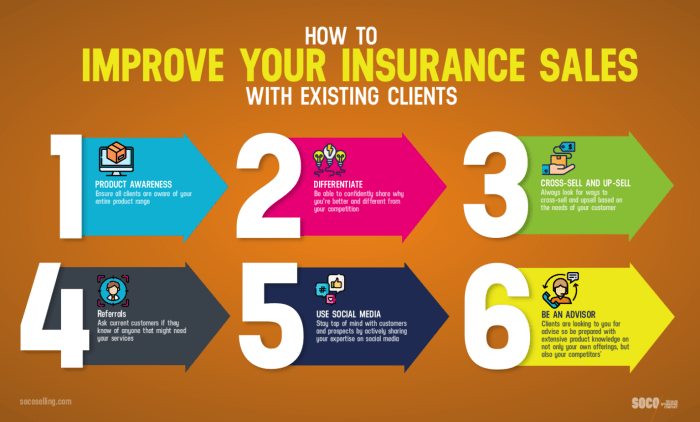Selling insurance tips and tricks unveils a treasure trove of invaluable insights, guiding you through the intricate art of establishing rapport, effectively communicating, and skillfully navigating objections. Dive into this comprehensive exploration to elevate your insurance sales strategies and achieve remarkable outcomes.
The content of the second paragraph that provides descriptive and clear information about the topic.
Selling Insurance

Effective Communication Techniques
Establishing rapport and building trust with potential clients is crucial in selling insurance. Here are some tips to enhance communication and foster a positive relationship:
- Be approachable and friendly: A warm and welcoming demeanor can put clients at ease and create a comfortable atmosphere for discussions.
- Listen actively: Pay undivided attention to what clients have to say, both verbally and nonverbally. Show empathy and understanding to demonstrate that you genuinely care about their concerns.
- Identify client needs: Ask thoughtful questions to determine the specific insurance needs and goals of each client. Tailor your recommendations to align with their unique circumstances.
- Present policies clearly: Use plain language and avoid technical jargon. Explain the coverage, benefits, and exclusions of policies in a way that clients can easily understand.
- Be patient and answer questions: Allow clients ample time to ask questions and address any concerns they may have. Provide clear and thorough explanations to ensure they make informed decisions.
Market Analysis and Segmentation for Insurance Sales
Understanding your target market is crucial for successful insurance sales. Market analysis and segmentation help you identify potential customers, tailor your marketing campaigns, and increase your chances of closing deals.
Demographics and Psychographics
Demographics include factors like age, income, education, and location. Psychographics encompass values, beliefs, and lifestyle preferences. Understanding both helps you create a detailed profile of your ideal customer.
Conducting Market Research
Conduct surveys, focus groups, and analyze industry data to gather insights about your target market. Identify their insurance needs, pain points, and decision-making criteria.
Identifying Customer Segments
Based on your research, divide your target market into distinct segments. Each segment should have unique characteristics, insurance needs, and marketing strategies.
Tailoring Marketing Campaigns
Develop tailored marketing campaigns for each customer segment. Use appropriate messaging, channels, and incentives that resonate with their specific demographics, psychographics, and insurance needs.
Lead Generation and Nurturing Strategies for Insurance: Selling Insurance Tips And Tricks
Generating and nurturing leads is crucial for insurance sales success. By implementing effective strategies, insurance professionals can attract potential customers, build relationships, and ultimately increase their sales conversions.
Lead Generation Channels
Explore various channels to generate leads, including:
- Online marketing: Utilize search engine optimization (), social media marketing, and pay-per-click (PPC) advertising to reach potential customers online.
- Networking: Attend industry events, join professional organizations, and engage with potential customers at networking functions.
- Referrals: Encourage existing customers to refer new prospects by offering incentives or building strong relationships.
Lead Nurturing Strategies
Nurture leads effectively through:
- Email campaigns: Create personalized email sequences that provide valuable content, offer solutions, and encourage engagement.
- Personalized content: Tailor content to the specific needs and interests of each lead, such as providing case studies, whitepapers, or webinars.
- Follow-up communication: Regularly follow up with leads to build relationships, address concerns, and move them through the sales funnel.
Lead Scoring and Qualification
Implement lead scoring and qualification systems to prioritize and focus efforts on the most promising leads. Consider factors such as:
- Engagement: Track lead behavior, such as email opens, website visits, and content downloads, to gauge their interest level.
- Demographics: Consider the lead’s industry, job title, and company size to assess their potential fit for your insurance offerings.
- Fit: Evaluate whether the lead’s needs and goals align with the solutions you provide.
Objection Handling and Negotiation Techniques

Addressing objections and negotiating terms are crucial aspects of insurance sales. By understanding common concerns and adopting effective strategies, insurance professionals can turn objections into opportunities and establish mutually beneficial agreements with clients.
When it comes to selling insurance, there are a few tips and tricks that can help you close more deals. One of the most important things is to understand your customers’ needs. What kind of car do they drive? What are their driving habits?
The more you know about your customers, the better you can tailor your sales pitch to their specific needs. For example, if you know that your customer drives a high-performance car , you can emphasize the importance of having adequate coverage in case of an accident.
Identifying Common Objections
Potential clients may raise various objections, including:
- Cost
- Coverage
- Exclusions
- Complexity
- Trust
Strategies for Addressing Objections
To effectively address objections, consider the following strategies:
- Listen Actively: Understand the client’s concerns and acknowledge their perspective.
- Empathize: Show empathy by demonstrating that you understand their point of view.
- Educate: Provide clear and concise information to address misconceptions or concerns.
- Reframe: Rephrase objections as opportunities to highlight benefits or address specific needs.
- Offer Alternatives: Suggest alternative solutions or customize coverage to meet the client’s concerns.
Negotiating Terms and Conditions
When negotiating terms and conditions, aim to maintain a positive relationship with the client while ensuring the agreement aligns with both parties’ interests:
- Be Flexible: Show willingness to compromise and adjust terms within reasonable limits.
- Communicate Clearly: Explain the terms and conditions thoroughly to avoid misunderstandings.
- Build Trust: Establish transparency and honesty throughout the negotiation process.
- Document the Agreement: Formalize the terms and conditions in writing to ensure clarity and accountability.
Customer Relationship Management (CRM) in Insurance Sales

Implementing a Customer Relationship Management (CRM) system is crucial for managing client relationships effectively in insurance sales. It provides a centralized platform to track customer interactions, manage policies, and deliver personalized service, ultimately enhancing customer satisfaction and retention.
Benefits of CRM in Insurance Sales, Selling insurance tips and tricks
- Centralized Customer Data: CRM systems consolidate all customer data, including contact information, policy details, and interaction history, in one accessible location.
- Improved Communication: CRMs facilitate seamless communication with customers through multiple channels, ensuring timely responses and personalized interactions.
- Automated Tasks: CRMs can automate repetitive tasks such as sending reminders, generating reports, and scheduling appointments, freeing up time for agents to focus on building relationships.
- Enhanced Customer Insights: CRMs provide valuable insights into customer behavior, preferences, and pain points, enabling agents to tailor their approach and offer relevant products and services.
- Increased Sales Opportunities: By tracking customer interactions and identifying potential needs, CRMs help agents identify cross-selling and upselling opportunities, increasing revenue generation.
Best Practices for Building Strong Customer Relationships
- Personalize Interactions: Use customer data to understand their unique needs and tailor communication accordingly.
- Provide Exceptional Service: Respond promptly to inquiries, resolve issues efficiently, and go the extra mile to exceed expectations.
- Build Trust: Be honest, transparent, and keep customers informed about policy changes and industry updates.
- Foster Long-Term Relationships: Stay in touch with customers after policy sales, offering value-added services and checking in regularly.
- Measure and Improve: Track customer satisfaction metrics and use feedback to identify areas for improvement and enhance the overall customer experience.
Clarifying Questions
What are the most effective communication techniques for selling insurance?
Establishing rapport, active listening, and presenting policies clearly are crucial communication techniques for insurance sales.
How can I identify and target potential insurance customers?
Conduct market research, understand target market demographics and psychographics, and develop tailored marketing campaigns for specific segments.
What strategies can I use to generate and nurture insurance leads?
Utilize online marketing, networking, and referrals for lead generation. Nurture leads through email campaigns, personalized content, and follow-up communication.




